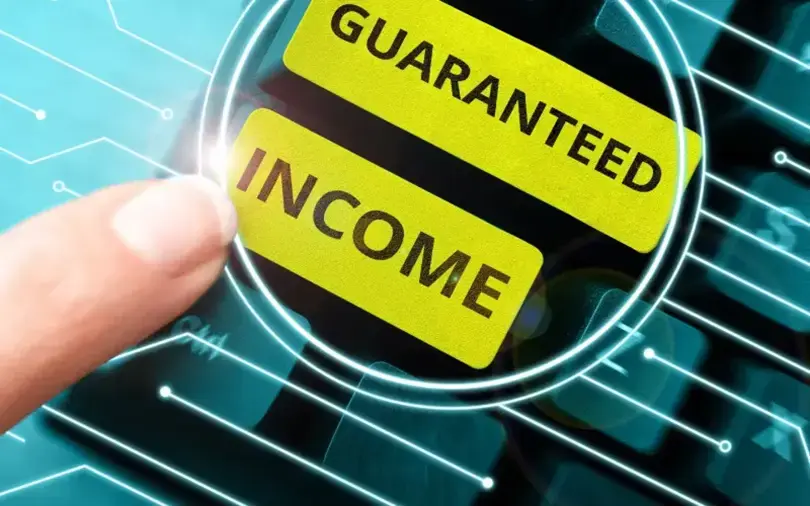A few years ago, the idea of guaranteed income sounded like science fiction. Getting money from the government every month — no questions asked? It seemed too good to be true.
But in 2025, California is one of the few states where these programs are real, growing, and helping thousands of people.
So, what is guaranteed income? Who gets these payments? And can it really change lives? Let’s find out.
What Is Guaranteed Income?
Guaranteed Income (GI) means giving people a fixed amount of money every month, no matter if they have a job or not. Unlike other aid programs, you don’t have to prove you’re poor or look for work. You get the money, and you can spend it however you want — on rent, food, medicine, education, or just living peacefully.
The idea is simple: give people enough money to live without constant stress about making ends meet. This helps them make better choices and focus on improving their lives.
Why Is It Needed?
The main goal is to reduce financial stress and poverty. Studies show that when people have a basic financial safety net, they make smarter decisions, invest in their health and education, and improve their job prospects.
It’s not just kindness — it can save money for the government too, by lowering costs for healthcare, homelessness, and crime.
Who Gets Guaranteed Income in California?
By 2025, California has launched more than 30 pilot GI programs in cities like Los Angeles, Sacramento, Oakland, San Francisco, San Jose, Fresno, and rural areas.
Here are some key groups receiving help:
So, what is guaranteed income? Who gets these payments? And can it really change lives? Let’s find out.
What Is Guaranteed Income?
Guaranteed Income (GI) means giving people a fixed amount of money every month, no matter if they have a job or not. Unlike other aid programs, you don’t have to prove you’re poor or look for work. You get the money, and you can spend it however you want — on rent, food, medicine, education, or just living peacefully.
The idea is simple: give people enough money to live without constant stress about making ends meet. This helps them make better choices and focus on improving their lives.
Why Is It Needed?
The main goal is to reduce financial stress and poverty. Studies show that when people have a basic financial safety net, they make smarter decisions, invest in their health and education, and improve their job prospects.
It’s not just kindness — it can save money for the government too, by lowering costs for healthcare, homelessness, and crime.
Who Gets Guaranteed Income in California?
By 2025, California has launched more than 30 pilot GI programs in cities like Los Angeles, Sacramento, Oakland, San Francisco, San Jose, Fresno, and rural areas.
Here are some key groups receiving help:
- Young moms: In San Francisco, a program called the Abundant Birth Project gives $1,000 per month to pregnant women and new mothers. This helps reduce stress during a tough time.
- Youth aging out of foster care: Young people aged 18–24 who leave foster care get money to help start adult life.
- Working poor: Many have jobs but still can’t cover basic needs. GI fills the gap.
- Artists and creatives: In Los Angeles, over 2,400 artists, writers, musicians, and actors get monthly payments to help with unstable incomes, especially after the pandemic.

How Do These Programs Work?
Every program is a bit different, but usually:
Real Stories
Sara, 26, single mom from Stockton:
Antonio, 21, former foster youth:
Laura, 38, artist from Pasadena:
Where Did It Start?
The first program began in 2019 in Stockton, thanks to Mayor Michael Tubbs. 125 people got $500 a month for two years.
After the program:
These results inspired many new programs statewide.
Every program is a bit different, but usually:
- Apply: People fill out an online form.
- Random selection: Most programs choose participants by lottery.
- Payments: Amounts range from $500 to $1,200 per month for 6 months to 2 years.
- No strings attached: Money doesn’t have to be paid back or reported on, though sometimes people answer surveys.
Real Stories
Sara, 26, single mom from Stockton:
- "Getting the payments let me skip night shifts at work. I had time for my baby and to apply for college. It’s not just money—it’s a chance to breathe."
Antonio, 21, former foster youth:
- "I worked two jobs but still couldn’t afford rent. Now I’m renting a room, studying to be an electrician, and finally see a future."
Laura, 38, artist from Pasadena:
- "$1,000 a month helped me rent a studio and get back to painting. My first show is this spring!"
Where Did It Start?
The first program began in 2019 in Stockton, thanks to Mayor Michael Tubbs. 125 people got $500 a month for two years.
After the program:
- 40% got better jobs or higher income.
- Stress, depression, and anxiety dropped.
- Most spent the money on food, rent, and clothes — not on alcohol or entertainment.
These results inspired many new programs statewide.

Who Pays for It?
Funding comes from:
This mix lets programs grow and try new ideas, from targeted help to universal income.
What Do Critics Say?
What’s Next?
In 2025, California is exploring:
There’s also growing talk about Universal Basic Income (UBI) — giving money to everyone, no matter their income. It’s still a debate but gaining interest.
Funding comes from:
- Private foundations: Economic Security Project, Blue Shield Foundation, Chan Zuckerberg Initiative.
- Government grants: California’s own CalGI program.
- City budgets: Some cities use local taxes.
This mix lets programs grow and try new ideas, from targeted help to universal income.
What Do Critics Say?
- Too expensive? Yes, scaling up costs billions. But poverty is costly too — in healthcare, homelessness, lost work.
- People will stop working? Most still work and even find better jobs because they feel secure.
- Doesn’t fix all problems? True — it’s not a magic fix, but part of a bigger solution.
What’s Next?
In 2025, California is exploring:
- Expanding to rural areas with higher poverty.
- Programs for elderly people, especially those living alone.
- Longer payment periods — 3 to 5 years instead of under a year.
There’s also growing talk about Universal Basic Income (UBI) — giving money to everyone, no matter their income. It’s still a debate but gaining interest.
*****
Guaranteed income isn’t just money. It’s an investment in people. It says, “We trust you to use this help wisely.”
Though still small in scale, these programs show that when people get support, they use it well. It’s not a perfect solution, but maybe one of the kindest steps toward a fairer future.






